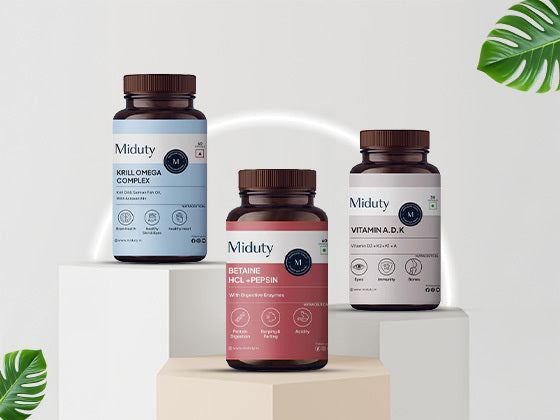Niacinamide, also known as vitamin B3, is a popular ingredient in skincare products because of its numerous skin benefits. Here are some things to remember when using niacinamide:
Do's:
-
Use it regularly: To see the benefits of niacinamide, make it a regular part of your skincare routine.
-
Look for a high concentration: Niacinamide is effective in concentrations of at least 2%. Higher concentrations can provide even more benefits.
-
Choose the right product: Niacinamide is available in serums, creams, and masks, among other forms. Choose the form that is most appropriate for your skin type and concerns.
-
Combine with other ingredients: Consider combining niacinamide with antioxidants, retinoids, and hydrating ingredients in your skincare routine to maximise the benefits of other active ingredients.
Don'ts:
-
Don't use vitamin C: Niacinamide and vitamin C can cause skin irritation and discoloration when used together, so it's best to use them at different times of the day.
-
Don't overuse: While niacinamide is generally well-tolerated, overusing it can cause redness and irritation, especially in people with sensitive skin.
-
Don't use it with exfoliating ingredients: Niacinamide can increase skin sensitivity, so it's best to avoid using it with exfoliating ingredients such as salicylic acid and glycolic acid.
-
Don't use it if you have an allergy: Niacinamide, like any other skincare ingredient, can cause allergic reactions in some people. Patch test the product before using it on your face if you have sensitive skin or a history of allergies.
What is Niacinamide?

Niacinamide is a derivative of Vitamin B3 (niacin), a necessary nutrient that the body uses for a number of processes. It is commonly used as a skincare ingredient because of its potential skin benefits, such as improving skin elasticity, reducing the appearance of fine lines and wrinkles, and supporting the skin's barrier function. Niacinamide has also been demonstrated to have anti-inflammatory and anti-pigmentation properties, as well as to support the improvement of skin tone and texture.
How to Apply Niacinamide in Your Skincare Routine

Vitamin B3 in the form of niacinamide is a popular skincare ingredient with many advantageous effects on the skin. Here's how to incorporate niacinamide into your skincare routine, step by step:
-
Cleanse: To begin, clean your face to remove any dirt, oil, or makeup. Use a gentle cleanser that will not remove your skin's natural oils.
-
Tone: After cleansing, use a toner to balance your skin's pH and prepare it for the following steps in your routine.
-
Serum: Apply a niacinamide serum to your face. It's best to use a product that contains at least 5% niacinamide. Gently massage the serum into your skin, making sure to cover your entire face.
-
Moisturize: Finish by hydrating your skin with a moisturiser. Because niacinamide can help improve skin barrier function, using a moisturizer will help lock in the serum's benefits.
-
Sun protection: To protect your skin from the damaging effects of UV rays, use a broad-spectrum sunscreen with an SPF of 30 or higher.
It's important to note that niacinamide can be used in both the morning and evening, as it's a non-irritating and safe ingredient for all skin types. To rule out any potential side effects, always patch-test any new skincare products before using them in your routine.
Benefits of Niacinamide in the Skincare Routine

Niacinamide is gaining popularity in skincare due to its numerous skin benefits. Some of the key advantages of incorporating Niacinamide into your skincare routine are as follows:
-
Improves skin barrier function: Niacinamide strengthens the skin barrier and prevents water loss, which can help improve the skin's overall health and appearance.
-
Reduces redness and inflammation: Niacinamide has been shown to reduce redness and inflammation, making it an excellent ingredient for those with sensitive or irritated skin.
-
Brightens skin tone: Niacinamide has been shown to brighten the skin and reduce the appearance of dark spots and hyperpigmentation.
-
Supports healthy ageing: Niacinamide has been shown to improve the production of ceramides and fatty acids, both of which are necessary for healthy skin. It also contains antioxidants, which can help protect against environmental stressors.
-
Minimises the appearance of fine lines and wrinkles: Niacinamide has been shown to increase collagen production, which can help to reduce the appearance of fine lines and wrinkles.
Who Can Use Niacinamide?

Niacinamide, is a water-soluble vitamin that is safe for people of all ages and skin types to use. It is a versatile ingredient that benefits the skin in a variety of ways, including improved skin tone and texture, reduced redness and inflammation, and increased hydration. The majority of people tolerate niacinamide well, and it has few side effects.
Below is a breakdown of who can benefit from using niacinamide:
-
Niacinamide is well tolerated by most skin types, including dry, oily, combination, sensitive, and acne-prone skin. Its gentle nature makes it ideal for people with sensitive or reactive skin who may be unable to tolerate more potent ingredients.
-
Niacinamide is especially beneficial to people with acne-prone skin. It regulates oil production, reduces inflammation, and diminishes the appearance of blemishes and acne scars. Furthermore, niacinamide has antimicrobial properties that can help fight acne-causing bacteria.
-
Niacinamide has anti-aging properties by increasing collagen production, improving skin elasticity, and reducing the appearance of fine lines, wrinkles, and hyperpigmentation. It promotes a more youthful complexion and can be incorporated into anti-aging skincare regimens to address a variety of ageing symptoms.
-
Niacinamide's soothing and anti-inflammatory properties make it ideal for people with sensitive or easily irritated skin. It helps to reduce redness, sensitivity, and strengthen the skin barrier, making it more resistant to external stressors.
-
Niacinamide effectively reduces hyperpigmentation, dark spots, and uneven skin tone. It inhibits the transfer of melanin to the skin's surface, resulting in a more even complexion over time. Niacinamide can be used in skincare routines for hyperpigmentation and melasma.
-
Niacinamide strengthens the skin barrier, increases moisture retention, and prevents water loss, making it ideal for people who have dry or dehydrated skin. It hydrates and plumps the skin, making it soft, smooth, and supple.
-
Niacinamide controls sebum production, making it ideal for people with oily or acne-prone skin. By balancing oil levels, niacinamide helps reduce shine, minimize the appearance of enlarged pores, and prevent breakouts without drying out the skin.
When to Apply Niacinamide: Day or Night?

Niacinamide, can be applied to the skin at any time of day or night. In fact, it is a multipurpose product that can be used in both morning and night-time skincare regimens. Niacinamide, when applied in the morning, can aid in defending the skin against environmental aggressors like pollution and sun exposure. It can also assist in enhancing the skin's natural barrier function, enabling it to retain moisture and protect against irritants from the outside.
Niacinamide can help the skin's natural repairing process while you sleep at night. It can also help regulate oil production and improve the appearance of fine lines and wrinkles in the morning, giving you a brighter and more even complexion.
Mixing/Layering Niacinamide with Other Active Ingredients

Niacinamide is a safe and adaptable ingredient for skincare that can be used in conjunction with a variety of other active ingredients. The compatibility of two or more ingredients is dependent on a number of factors, including the pH levels, concentrations, and formulations of the products. Some common active ingredients that can be combined or layered with niacinamide are as follows:
-
Vitamin C: Niacinamide and Vitamin C are both antioxidants that can complement one another and benefit the skin more when used together. However, it is critical to use products containing a stable form of Vitamin C and to layer them carefully, as the combination of niacinamide and ascorbic acid can affect Vitamin C stability.
-
Retinoids: Niacinamide can be combined with retinoids such as retinol, but the pH level of the retinoid product should be compatible with niacinamide for the best results.
-
Hyaluronic Acid: Both niacinamide and hyaluronic acid are hydrating ingredients that can be combined to provide additional hydration to the skin.
-
AHA/BHA: Alpha Hydroxy Acids (AHAs) and Beta Hydroxy Acids (BHAs) can be combined with niacinamide, but the pH levels of the products must be compatible for the best results.
The key to successfully mixing or layering niacinamide with other active ingredients is to consider your skin's specific needs and responses. If you have any concerns or questions about combining specific ingredients, talk to a dermatologist or skincare expert for personalised advice.
Niacinamide and Hyaluronic Acid

Niacinamide and hyaluronic acid are both popular skincare ingredients. Niacinamide is a type of vitamin B3 that is frequently used in skin care products because of its ability to improve the skin barrier, reduce inflammation, and boost the skin's natural production of ceramides, which aid in moisture retention. Niacinamide can also help with fine lines, hyperpigmentation, and redness. In contrast, hyaluronic acid is a substance that the body produces naturally and that helps to hydrate the skin and retain water. It is an effective skin moisturizer because it can hold up to 1,000 times its weight in water. In skin care products, hyaluronic acid and niacinamide can be combined to increase hydration and benefit the skin.
Here's how each ingredient functions and why they are frequently used together:
-
Niacinamide (Vitamin B3):
-
Niacinamide is a versatile ingredient that provides numerous skincare benefits. It improves skin texture, strengthens the skin barrier, regulates oil production, minimises the appearance of pores, and reduces hyperpigmentation. Furthermore, niacinamide has anti-inflammatory properties, making it useful for reducing redness and soothing irritated skin.
-
Niacinamide is well tolerated by the majority of skin types, including sensitive and acne-prone skin. It is regarded as a gentle but effective ingredient suitable for daily use.
-
Hyaluronic Acid:
-
Hyaluronic acid is a hydrating ingredient that attracts and retains moisture in the skin, plumping, smoothing, and hydrating the surface. It also improves skin elasticity, reduces the appearance of fine lines and wrinkles, and promotes a dewy, youthful complexion. Hyaluronic acid occurs naturally in the skin but diminishes with age, making it a popular ingredient in skincare products.
-
Hyaluronic acid is effective on all skin types, including dry, oily, sensitive, and acne-prone skin. It is a lightweight, non-comedogenic ingredient that delivers intense hydration without clogging pores or leaving the skin greasy.
Vitamin C and Hyaluronic Acid

Vitamin C is a potent antioxidant that can help protect the skin from free radical damage. It can also help to brighten and improve the appearance of the skin by reducing the appearance of hyperpigmentation and uneven skin tone. Vitamin C can also stimulate collagen production, which keeps the skin firm and youthful.
Here's how each ingredient works and why they are commonly used together:
-
Vitamin C:
-
Vitamin C is a potent antioxidant that protects the skin from free radical damage caused by UV rays, pollution, and other environmental factors. It also brightens the complexion, reduces hyperpigmentation and dark spots, and stimulates collagen production, resulting in firmer, more youthful-looking skin. Furthermore, vitamin C has anti-inflammatory properties, making it useful for reducing redness and soothing irritated skin.
-
Vitamin C is suitable for the majority of skin types, including sensitive and acne-prone skin. However, it can become unstable and degrade when exposed to light, air, or water. To ensure maximum effectiveness, use stabilised forms of vitamin C such as ascorbic acid, tetrahexyldecyl ascorbate, or sodium ascorbyl phosphate.
-
Hyaluronic Acid:
-
Hyaluronic acid is a hydrating ingredient that attracts and retains moisture in the skin, plumping, smoothing, and hydrating the surface. It also improves skin elasticity, reduces the appearance of fine lines and wrinkles, and promotes a dewy, youthful complexion. Hyaluronic acid occurs naturally in the skin but diminishes with age, making it a popular ingredient in skincare products.
-
Hyaluronic acid is effective on all skin types, including dry, oily, sensitive, and acne-prone skin. It is a lightweight, non-comedogenic ingredient that delivers intense hydration without clogging pores or leaving the skin greasy.
Hyaluronic acid is a naturally occurring substance in the body that aids in the hydration of the skin. It has a high water retention capacity, making it an effective ingredient for combating dryness and keeping the skin looking plump and hydrated. By giving the skin a more youthful and lifted appearance, hyaluronic acid can also help to improve the appearance of fine lines and wrinkles. When used together, vitamin C and hyaluronic acid can be a highly effective skincare combination. Vitamin C can help protect the skin from damage, while hyaluronic acid helps to hydrate and plump it, creating a brighter and more youthful-looking complexion. However, it's important to keep in mind that the effectiveness of these ingredients will depend on the quality and concentration used in the products, as well as individual skin type and condition.
Niacinamide and Moisturizer

Niacinamide is a B3 vitamin with several skin benefits. It has been demonstrated to enhance the function of the skin's barrier, which may help with hydration and wrinkle reduction. Niacinamide is the most popular ingredient in many skincare products because of its anti-inflammatory and brightening properties. A moisturizer, on the other hand, is a product designed to hydrate and protect the skin from drying out. Moisturizers, which come in lotions, creams, and ointments, can be used to treat a wide range of skin problems, including dryness, flakiness, and roughness. Combining a niacinamide-containing product with a moisturizer is a great way to get the most out of both ingredients. The niacinamide can help to improve the overall health of the skin, while the moisturizer hydrates and protects it from further drying. It is critical to choose a moisturizer that is suitable for your skin type, as some may be too heavy or too light.
This is how they work together:
-
Niacinamide (Vitamin B3):
-
Niacinamide is a versatile ingredient known for its numerous skincare benefits. It improves skin texture, strengthens the skin barrier, regulates oil production, minimises the appearance of pores, and reduces hyperpigmentation. Furthermore, niacinamide has anti-inflammatory properties, making it useful for reducing redness and soothing irritated skin.
-
Niacinamide is well tolerated by the majority of skin types, including sensitive and acne-prone skin. It is regarded as a gentle but effective ingredient suitable for daily use.
-
Moisturizer:
-
Moisturizers help to hydrate the skin, maintain its natural moisture barrier, and prevent water loss, leaving it soft, smooth, and supple. They also soothe and protect the skin from environmental stressors like dry air, pollution, and UV rays.
-
Moisturizers are available in a variety of formulations designed to address specific skin types and concerns, ranging from lightweight lotions for oily skin to rich creams for dry skin. Choose a moisturiser that is appropriate for your skin type and addresses any specific concerns you may have.
Niacinamide and Retinol

Niacinamide and retinol are two popular skincare ingredients that have different skin benefits. Niacinamide is a type of vitamin B3 that has been shown to improve skin elasticity and even skin tone, reduce redness and blotchiness and improve skin barrier function. It helps treat acne and lessen the visibility of wrinkles and fine lines. On the other hand, retinol, a derivative of vitamin A, is well known for its anti-aging benefits. By boosting cell turnover, retinol makes wrinkles, age spots, and fine lines less noticeable. Its ability to open pores and improve skin texture makes it a popular ingredient for acne-prone skin. Niacinamide and retinol can be used together in a skincare routine, even though they both work well. It is important to note, however, that retinol can be quite strong and cause skin irritation in some people, so it is best, to begin with, a low concentration and gradually increase your use of it. Furthermore, niacinamide should be used in the morning and retinol at night, as retinol can make the skin more sensitive to sunlight. Here's an overview of each ingredient and how they can work together:
-
Niacinamide (Vitamin B3):
-
Niacinamide is a versatile ingredient that provides numerous skincare benefits. It improves skin texture, strengthens the skin barrier, regulates oil production, minimises the appearance of pores, and reduces hyperpigmentation. Furthermore, niacinamide has anti-inflammatory properties, making it useful for reducing redness and soothing irritated skin.
-
Niacinamide is well tolerated by the majority of skin types, including sensitive and acne-prone skin. It is regarded as a gentle but effective ingredient suitable for daily use.
-
Retinol (Vitamin A):
-
Retinol is a type of vitamin A that is well known for its anti-aging benefits. It stimulates collagen production, promotes cell turnover, and minimises the appearance of fine lines, wrinkles, and hyperpigmentation. Retinol also improves skin texture and tone, resulting in a smoother, more radiant complexion.
-
Retinol is effective for most skin types, but it can cause sensitivity, irritation, and dryness, especially when first used or at high concentrations. To reduce the risk of irritation, start with a lower concentration of retinol and gradually increase your usage.
Niacinamide and Salicylic Acid

Niacinamide and salicylic acid are two active ingredients commonly found in skincare products. Niacinamide, also known as vitamin B3, is a water-soluble vitamin that has been shown to improve skin barrier function, reduce fine lines and wrinkles, and improve overall skin appearance. It also has brightening and anti-inflammatory properties, making it a popular ingredient for those who have uneven skin tone or redness. Here's how they function and why they are commonly used together:
-
Niacinamide (Vitamin B3):
-
Niacinamide provides a variety of skin benefits. It improves skin texture, strengthens the skin barrier, regulates oil production, minimises the appearance of pores, and reduces hyperpigmentation. Furthermore, niacinamide has anti-inflammatory properties, making it useful for reducing redness and soothing irritated skin.
-
Niacinamide is well tolerated by most skin types, including sensitive and acne-prone skin. It is regarded as a gentle yet effective ingredient that can be used daily.
-
Salicylic Acid:
-
Salicylic acid is a beta hydroxy acid (BHA) that exfoliates the skin by penetrating the pores. It helps to unclog pores, remove excess oil and dead skin cells, and treat acne and blackheads. Salicylic acid also has anti-inflammatory properties, making it useful for reducing the redness and inflammation associated with acne.
-
Salicylic acid is ideal for oily, acne-prone, and combination skin types. It can be drying or irritating to some people, particularly if used in high concentrations or too frequently. To reduce the risk of irritation, start with lower concentrations and gradually increase your usage.
In contrast, salicylic acid is a type of beta-hydroxy acid (BHA) that is commonly used to treat acne-prone skin. It exfoliates the skin, unclogs pores, and reduces the production of sebum, the oil that contributes to the formation of pimples and blackheads. Salicylic acid also has anti-inflammatory properties, making it an effective ingredient for reducing acne-related redness and swelling. While both niacinamide and salicylic acid can help improve the appearance of the skin, it is critical to use them correctly. Although niacinamide and salicylic acid can be used in the same skincare routine, it is important to alternate their use or apply them at different times of the day because using them together may cause skin irritation. It's also critical to follow the product label's instructions, as using too much of either ingredient can cause skin irritation and dryness.
Niacinamide with AHA and BHA

Niacinamide, Alpha-Hydroxy Acids (AHA), and Beta-Hydroxy Acids (BHA) can work together to improve the appearance of skin. A type of vitamin B3 called niacinamide has been shown to have several benefits for the skin, including a reduction in the appearance of fine lines and wrinkles, an increase in skin elasticity, and support for a uniform skin tone. Exfoliating acids such as AHAs and BHAs help to remove dead skin cells, unclog pores, and improve skin texture. Even though AHAs and BHAs can be irritating, they should always be used carefully and follow the guidelines on the product label. Here's how each ingredient functions and how they can complement one another:
-
Niacinamide (Vitamin B3):
-
Niacinamide is a versatile skincare ingredient that improves skin texture, reduces the appearance of pores, minimises fine lines and wrinkles, and brightens the complexion. It also improves the skin's barrier, regulates oil production, and reduces inflammation.
-
Niacinamide is well tolerated by the majority of skin types, including sensitive and acne-prone skin. It is compatible with a wide range of skincare ingredients and can be combined with other active ingredients without causing significant irritation.
-
Alpha Hydroxy Acids (AHAs):
-
AHAs like glycolic acid, lactic acid, and mandelic acid are frequently used in skincare products to exfoliate the skin by loosening dead skin cells, promoting cell turnover, and revealing smoother, brighter skin.
-
AHAs improve skin texture, reduce the appearance of fine lines and wrinkles, fade hyperpigmentation and dark spots, and increase skin radiance.
-
While AHAs can be effective for most skin types, they may cause sensitivity, particularly in people with sensitive or reactive skin. To reduce the risk of irritation, start with low concentrations and gradually increase the frequency.
-
Beta Hydroxy Acids (BHAs):
-
Salicylic acid is the most widely used BHA in skincare products. It is oil-soluble, which makes it ideal for exfoliating inside the pores, removing excess oil, and treating acne and blackheads.
-
BHAs unclog pores, reduce acne breakouts, control oiliness, and improve skin clarity. They also have anti-inflammatory properties, which make them ideal for acne-prone and sensitive skin.
-
BHAs are well-tolerated by most skin types, including oily and acne-prone skin. However, they can be drying or irritating for some individuals, especially if used in high concentrations or too frequently.
AHAs and BHAs can affect the stability of niacinamide when combined with it because of the different pH levels between them. It's typically best to use niacinamide first, followed by AHA/BHA products, or to alternate using them on different days. It's also important to wear sunscreen because AHAs and BHAs can make your skin more sensitive to UV rays.
Takeaway: Prevent Acne and Reduce Signs of Ageing with Star Ingredient Niacinamide!

Niacinamide, also known as vitamin B3, has several skin benefits. It can help prevent acne by regulating the production of sebum, a skin oil that can cause clogged pores and breakouts. It has been demonstrated to increase skin hydration, lessen visibility, and improve the appearance of fine lines and wrinkles, making niacinamide a fantastic anti-aging ingredient. It is commonly used in skincare products at concentrations of 2-5% and is well tolerated by most skin types. It is available in serums, creams, and lotions, among other forms. While niacinamide has numerous benefits, everyone's skin is unique, and what works for one person may not work for another. Patch test a small area of skin before applying it all over your face is always a good idea with any new skincare product to ensure there are no adverse reactions.










































2 comments
Mischka Lorgat
I am interested in updates on latest research and releases on facial products for home usage
I am interested in updates on latest research and releases on facial products for home usage
Pamela Kline
Can i use Niacinamide 10% Zinc 1% with lotion containing peptides like south beach Repair and Release Cream?
Can i use Niacinamide 10% Zinc 1% with lotion containing peptides like south beach Repair and Release Cream?